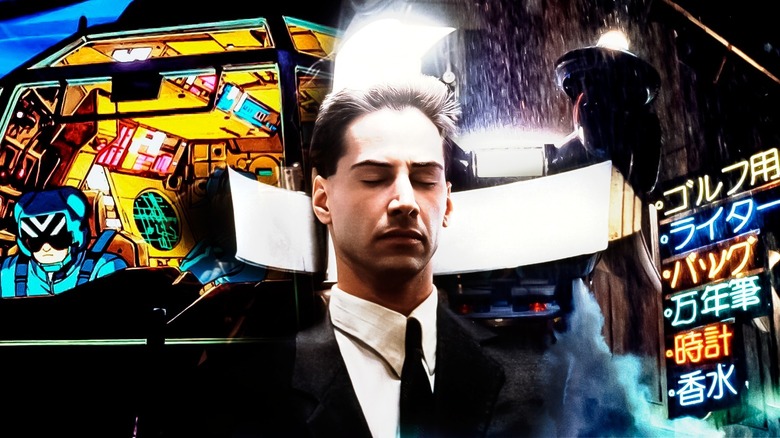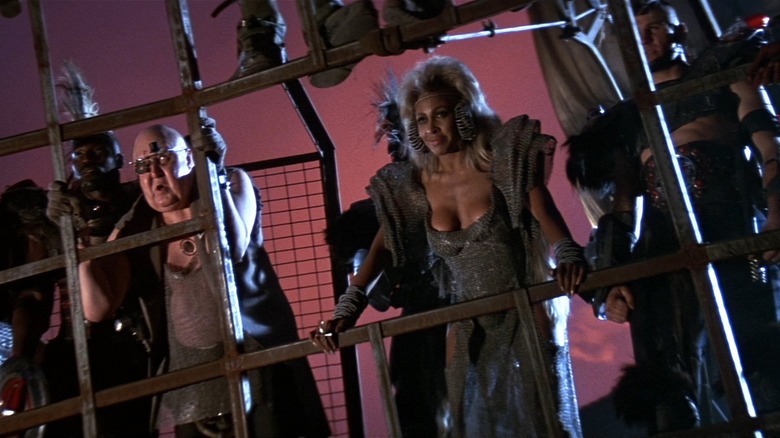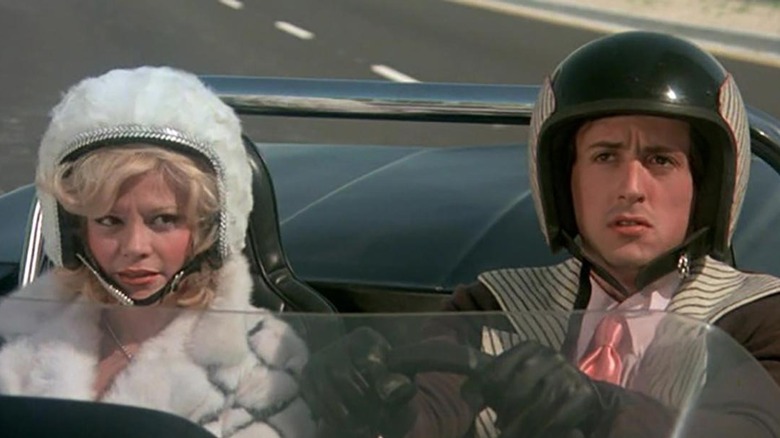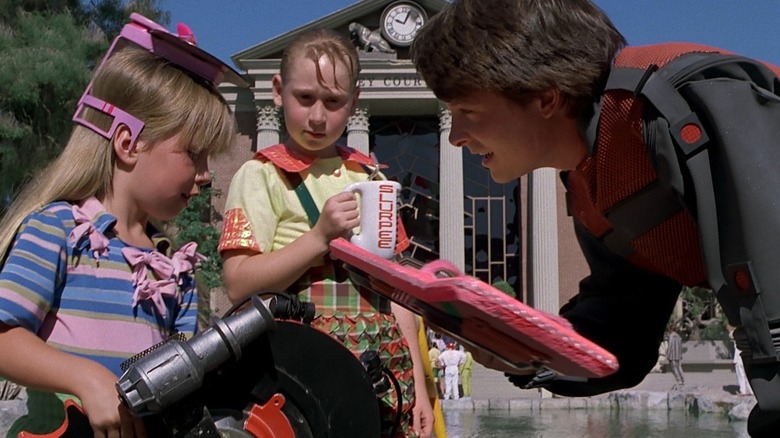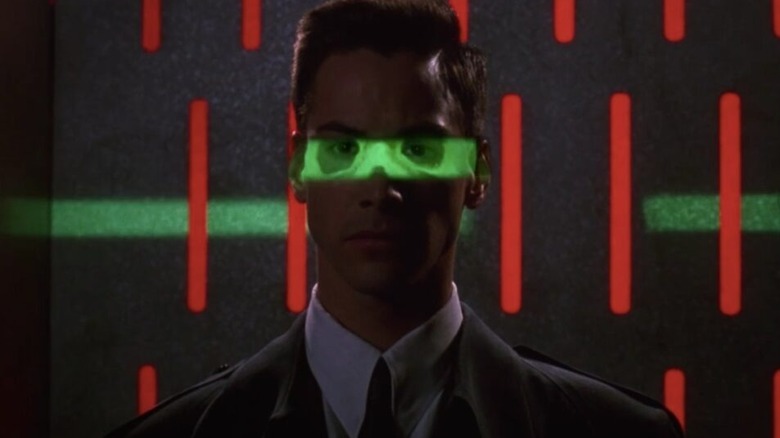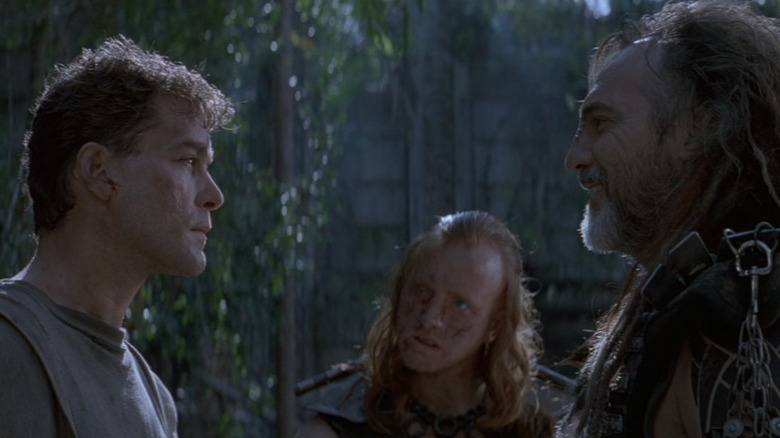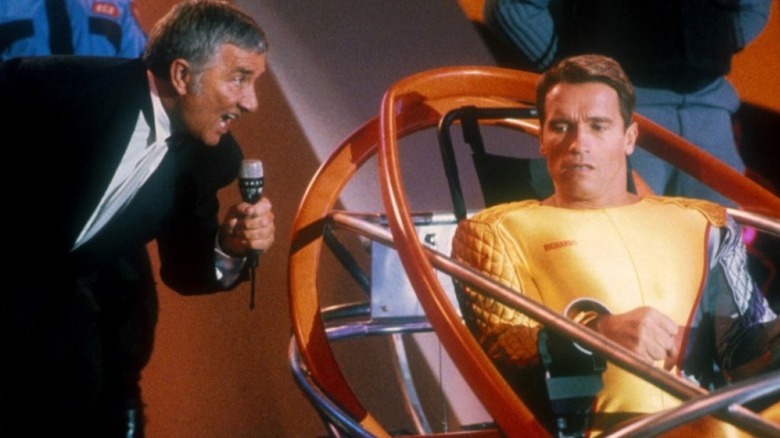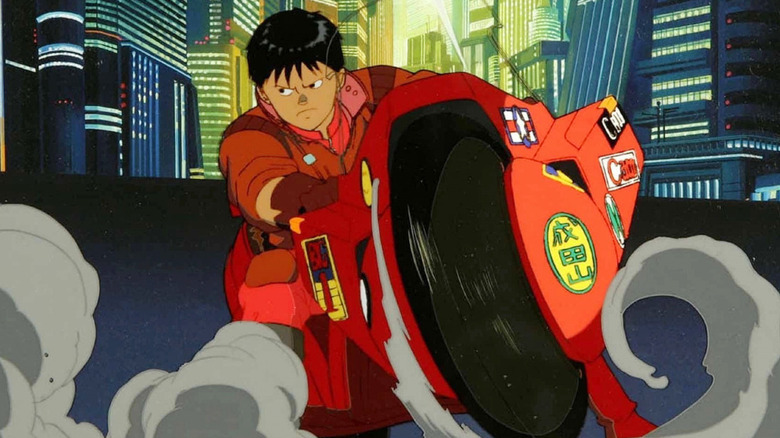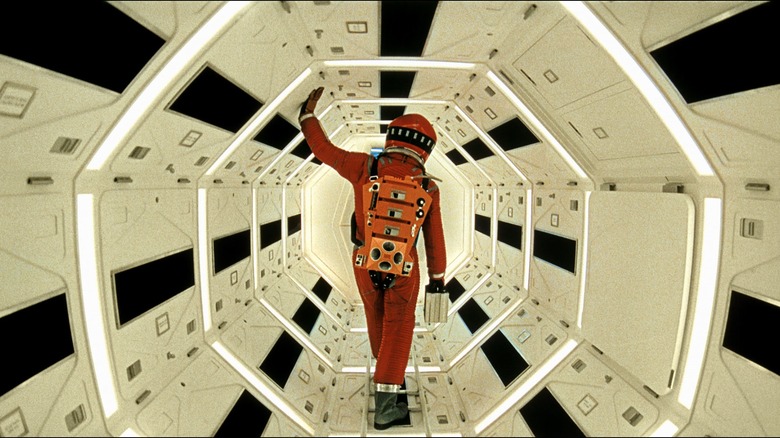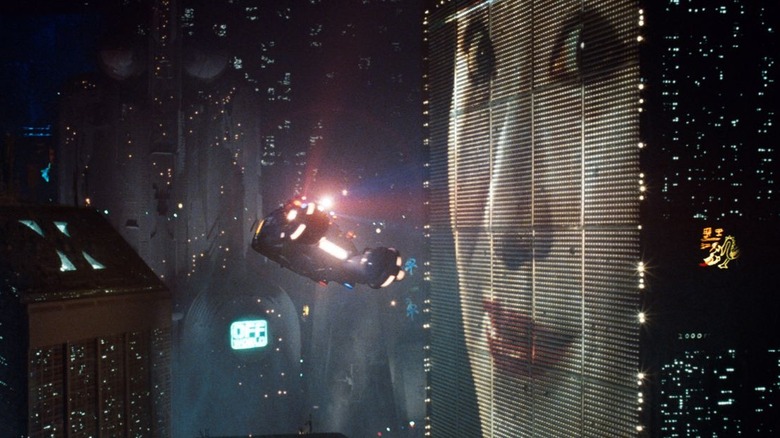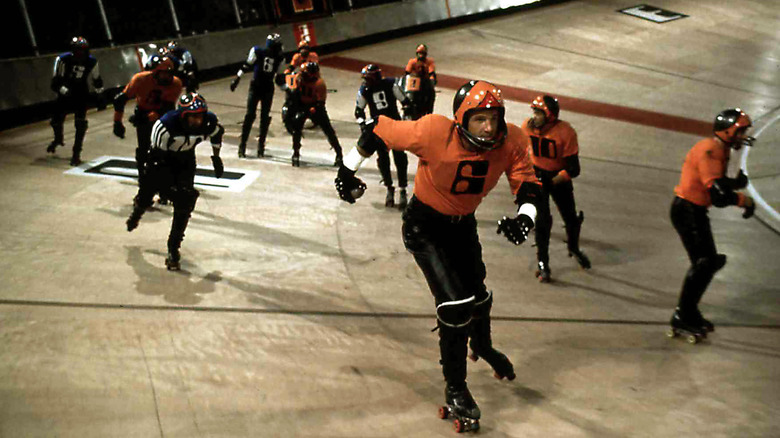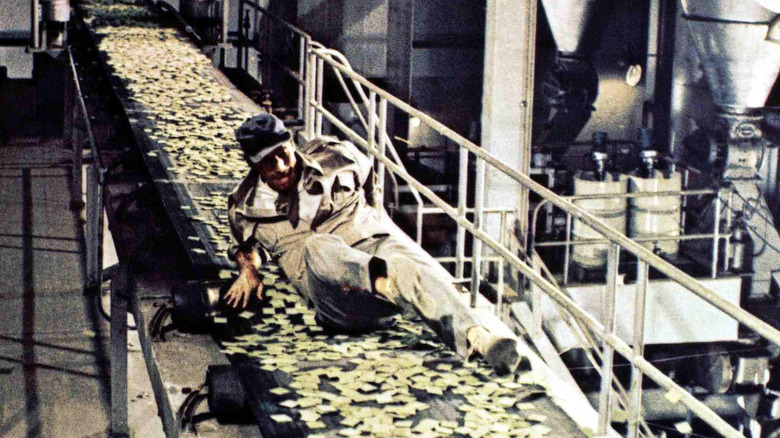Movies About The Distant Future That Now Take Place In Our Past
Movies have always enjoyed looking at and imagining the future. Among the earliest examples of this is 1930's "Just Imagine," which predicts New York City in the then-far-off year of 1980. Remarkably, the movie even gets a few things alarmingly close to accurate, envisioning towering skyscrapers and crowded urban streets lined with telephone lines and electric lights. Of course, the question of whether such films predicted the future or simply helped to inform it is one that has been debated for many years, and has only gained complexity as more and more old movies about the future have "come true," as it were.
The problem with setting a film in a specified year in the future is that, sooner or later, that year will actually come to pass — immediately dating the once forward-looking movie. That issue is probably why so much sci-fi takes place hundreds, if not thousands, of years ahead of when it was created. Some movies even go so far ahead that a fifth digit has to be added to the year, as is the case with both "Dune" and "Mortal Engines." The same can't be said for the movies in this feature, which imagined a distant future at the time of their release but have since seen their setting surpassed by the real-life calendars on our walls.
Mad Max Beyond Thunderdome -- released in 1985, set in mid-2000s
The original "Mad Max" movie, released in 1979, imagined a near-future post-apocalypse where oil is scarce and droughts are rampant — no doubt spurred on by the real-life energy crisis of that decade. Given the gas shortages and other issues, it wasn't all that difficult to imagine how much worse things might get in just a few years if oil supplies continued to fail to meet demand. The second movie, "The Road Warrior," skips ahead a few years to a setting near the end of the 1980s — still keeping it in the same decade of the movie's 1981 release.
But with the third installment, "Mad Max Beyond Thunderdome," the time jumps 15 years ahead of the events of the second movie and further separates the span between the movies' release dates and their time periods. Released in 1985 but set sometime in the mid-2000s, the "Mad Max" series was no longer a near-future apocalypse but now depicting a far off one. Eventual sequel "Mad Max: Fury Road" would continue this trend of pushing out the setting progressively farther, seeming to take place 30-40 years after its 2015 release date — though that doesn't change the fact that we've since cruised well beyond the time period of the first three movies.
Death Race 2000 -- released in 1975, set in 2000
In the 1970s, filmmakers seemed to really start latching onto the idea that in the future, humans would compete in various competitions that involve willfully murdering one another for sport. One of the trailblazers of this genre was 1975's "Death Race 2000," set in the titular year and featuring an early role for Sylvester Stallone. As the title suggests, the movie is about a violent race where drivers not only try to take out their competitors and their vehicles, but are even encouraged to run over pedestrians for extra points.
On a superficial level, "Death Race 2000" didn't accurately predict very much about the turn of the century except for maybe video games with similar concepts, "Twisted Metal" and "Carmageddon" being two of the more obvious and well-known examples. Still, it's hard not to draw parallels to what the movie is suggesting about the kind of edgy, sensationalist, trainwreck-esque reality television that began to grow in popularity during the 2000s. We might not have yet gotten to where we are willing to watch an actual "Squid Game" or "Battle Royale," but we sure do continue to love watching fictional movies and shows that depict such competitions.
"Death Race 2000" ended up birthing an entire movie franchise of sequels and reboots, the most recent being 2017's "Death Race 2050," which takes the series all the way to the middle of this century.
Back to the Future Part II -- released in 1989, set in 2015
There is perhaps no other single movie that set '80s kids up for greater disappointment about how the future was going to play out than "Back to the Future Part II." Within the first few scenes, it was promised that flying cars, hoverboards, self-tying shoes, video calls, celebrity robot waitstaff, and whole pizzas at the push of a button where all going to be available by the time younger Gen Xers and older Millennials hit adulthood.
We have since cruised well beyond the 2015 of the movie's future setting, and we only have a couple of those things — and some of them come with a huge asterisk, like the so-called hoverboards that are currently available that don't exactly hover. To be fair, the movie does seem to correctly predict several technological advances that we currently enjoy, but most of it is an exaggerated version of what has been the reality so far. Given the problems we've seen just with self-driving cars, though, it seems like a no-brainer that no one should be in a huge rush for mass market flying cars anytime soon.
One unique thing about "Back to the Future Part 2" is that stars Michael J. Fox, Elisabeth Shue, and Thomas Wilson were all given make-up that imagined how their characters might look in 2015 — and we're now able to see how accurate that make up was. As shown in side-by-side comparisons by Digital Spy in 2017, the actors had yet to come anywhere close to looking as old and wrinkled in real life as they did in the movie.
Johnny Mnemonic -- released in 1995, set in 2021
While "The Matrix" is probably Keanu Reeves' most futuristic-feeling movie franchise to date, those films are actually set in the present of when the movies were released, and only seem futuristic because they take place largely inside of a computer simulation. Reeves is no stranger to actual time travel in his films, however, starting that trend early with the many glimpses of the future in the "Bill & Ted" series. But we aren't yet in the most excellent future paradise depicted in those movies — that's still about 600 years off.
By the mid-1990s, Reeves was plenty prolific but found himself in a number of films that weren't especially memorable. It's easy to forget that "Johnny Mnemonic" ever existed, even as we have now put its 2021 setting behind us. Based on the novel by William Gibson, considered one of the trailblazers of the cyberpunk genre best known for his "Neuromancer" series, it's easy to see that the 1995 movie is rooted in an early-'80s vision of the future where people have grown dangerously reliant on and addicted to cybernetic brain implants and virtual worlds.
Thankfully, we aren't quite there yet — even if Mark Zuckerberg really, really wants us to be.
No Escape -- released in 1994, set in 2022
This is probably the least well-known movie on the list, but one you'll often find brought up in articles about underrated gems or best movies you never saw. Directed by Martin Campbell of "Goldeneye" and "Casino Royale" fame and starring the late Ray Liotta, "No Escape" takes place in a version of 2022 where private corporations run all the jails and the prisoners are considered expendable assets. Liotta plays John Robbins, an ex-Marine serving a life sentence for killing his commanding officer rather than carry out his commander's orders to murder civilians. John is eventually transferred to an island called Absolom, a place reserved for the worst and most dangerous prisoners which has been taken over by a group called the Outsiders.
Once the action moves over to Absolom, "No Escape" becomes very "Mad Max"-esque in terms of both the clothing worn by the Outsiders and the overall post-apocalyptic feel. Campbell obviously knows how to stage an awesome action scene, and that's one area where this movie definitely excels. There's nothing particularly futuristic about "No Escape" that feels embarrassing now that 2022 has come and gone, other than the assumption in the last couple decades of the 20th century that everyone was going to wear a lot of leather and chains by this point in history.
The Running Man -- released in 1987, set in 2017
Based on the 1982 book by Stephen King — under his Richard Bachman pen name — "The Running Man" was yet another movie from the '70s/'80s that correctly predicted society's eventual obsession with reality television. Like most of its peers, though, it takes things to an extreme that we thankfully haven't quite gotten to yet, centering on a television show where criminals have to literally run for their lives from armed mercenaries.
Of course, given that this is a 1980s movie about the 2010s, star Arnold Schwarzenegger is wearing a bright yellow bubble jumpsuit and his opponents are decked out in spiked leather elbow pads, oversized mohawks, and the like. It's the kind of vision of the future that already felt hilariously out of date just a few years after the movie was released. Still, a lot of what the movie predicted about the future of reality television wasn't completely off-base, and its basic concept would go on to be revisited in some form in countless other movies, television shows, comic books, and video games over the years.
Check back in 2085 when we update this list to include 1990's "Total Recall" as another Schwarzenegger movie about a far-off future whose setting has passed.
Akira -- released in 1988, set in 2019
Though "Speed Racer" and "Voltron" did their parts, the classic 1988 film "Akira" is often cited as the moment when anime first reached not only North American but non-Japanese audiences as a whole in a significant way. It wasn't long before a lot more anime films and television shows began to see localization in the U.S., with series showing up on major American cable stations and movies being brought over with huge companies like Disney pitching in on the efforts to help make anime big business in the states.
Taking place in a then-far future 2019, "Akira" wasn't just a trailblazer in anime but in adult animation as a whole, as well as the entire cyberpunk genre. Katsuhiro Otomo's manga of the same name on which the movie was based is considered one of the earliest uses of the term "Neo Tokyo," which has come to be a commonly used way to indicate that a story is set in a fictional futuristic version of Tokyo. Even if the cyberpunk nightmare future of "Akira" hasn't yet come true, the impact that the movie had on art is impossible to measure. There is an article on Vice with a headline that makes the bold statement that "Akira" has "influenced all your favorite TV, film and music" — and honestly, they aren't wrong.
2001: A Space Odyssey -- released in 1968, set in 2001
Filmmaker Stanley Kubrick seemed to have an affection for stories about the future, having chosen multiple books about the subject to adapt to film. From "A Clockwork Orange" to "A.I. Artificial Intelligence" — the latter of which Kubrick had been developing with Steven Spielberg prior to his death, with Spielberg eventually reviving and finishing the project himself — Kubrick enjoyed putting challenging and unusual visions of the future on the big screen, typically ones that didn't speak particularly highly about where we are headed as a species. But nowhere was this tendency more obvious or better-realized than via his 1968 sci-fi opus, "2001: A Space Odyssey."
While the ambitious "2001" takes huge leaps across the entire human timeline — beginning all the way back in the prehistoric era at the moment when apes begin evolving into humans — the year 2001 clearly takes a starring role in the movie's sequence of events. Putting aside the fact that, decades into the 21st century, we still haven't reached the point of human-based space travel beyond the moon, it's impossible not to be shocked by how close AI programs like Siri and ChatGPT are to HAL 9000 — surely seen as some far-fetched technology that was still hundreds of years off when the movie was first released. As pointed out by the website Live Science, some experts have suggested that AI as intelligent and as dangerous as HAL 9000 already exists, and the late Stephen Hawking considered AI one of humanity's biggest threats.
It's worth nothing that "2001" also had a sequel called "2010: The Year We Make Contact," set in that year and released in 1984.
Blade Runner -- released in 1982, set in 2019
Of all the movies in this feature, "Blade Runner" is the only one that predicted robotics would be so advanced by now that synthetic humans could walk among us and we wouldn't be able to distinguish them from regular people. Based on the novel "Do Androids Dream of Electric Sheep?," "Blade Runner" didn't have an easy path to its reputation as the widely-established sci-fi classic that we know it as today. The production was troubled, director Ridley Scott's battles with the studio resulted in multiple versions of the movie (to the point that there still isn't a clear-cut consensus as to which is the best or most definitive version), and it wasn't particularly well-liked by critics upon its original release.
As if Harrison Ford's legacy wasn't already secured by having played both Han Solo and Indiana Jones, "Blade Runner" allowed him to add another iconic movie character to his resume by way of protagonist Rick Deckard — a former cop whose new career is hunting down and eliminating replicants. But Deckard soon finds that both humanity's relationship to the bioengineered humanoids isn't quite as black and white as her previously thought. In fact, there was an ongoing debate for years as to whether Deckard himself was actually a replicant, with different cuts of the film leaving conflicting clues in that regard.
It's a question that was finally answered in "Blade Runner 2049," the 2017 sequel that somehow managed to be just as good as, if not better, than its vaunted predecessor. Luckily, it managed to come out before the calendar hit 2019 in the real world and made sure to zip things ahead another few decades so that the "Blade Runner" series was taking place well into the future once again.
Rollerball -- released in 1975, set in 2018
Along with "Death Race 2000," 1975 also saw the release of another movie that predicted a future where humanity enjoys watching people murder each other for sport. What's interesting about "Rollerball" is that, while it attempts to set its events in the distant future of 2018, it depicts a sport — roller derby — that was very of its time and would soon feel laughably dated, though it has since come back around again and has seen several resurgences in popularity in recent decades.
James Caan stars as Jonathan E., star player of Houston's Rollerball team. Not to sound like a broken record, but once again we see a future where huge corporations control everything and have a tendency to force people to compete in excessively violent sports. However, that isn't all that's going on here — as layers of the surprisingly deep (for this genre) plot are peeled away, it's revealed that said corporations have taken to digitizing all of the world's books and literature onto supercomputers. All the while, they're also using this process as an opportunity to edit and censor the books to their liking.
Shifting from physical to digital media? Check. The editing and censoring of books? Also check. It turns out that this seemingly silly movie about lethal roller derby has a lot more going on that it might seem, and a lot of it has proven to be frighteningly prescient.
Soylent Green -- released in 1973, set in 2022
It's easy to laugh at a movie like "Soylent Green," especially given that its most famous moment is star Charlton Heston's completely ridiculous delivery of the line, "Soylent Green is people!" with arms outstretched for melodramatic effect. To be sure, it's hard to imagine how making foodstuffs out of human beings could ever be something that can not only be gotten away with in the first place, but actually be safe and cost effective. Still, the 1973 thriller does end up hitting a few things about its 2022 setting right on the head.
In an examination of the film by Arizona State University released in 2022, it's pointed out that the movie was not only surprisingly close to how much larger the population was going to be by that year, but it actually underestimated the current world population by almost 1 billion people. The movie was also correct in predicting that housing in major cities like New York was going to become prohibitively expensive to the average person. And while jelly hasn't quite hit $150 a jar like it does in the film, there's no denying what inflation has done to food prices since 2021.
"Soylent Green" might go to ridiculous extremes, most notably the big twist it's built around, but it definitely gets an uncomfortable amount of things right about the year in which it was set.
